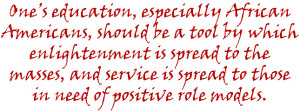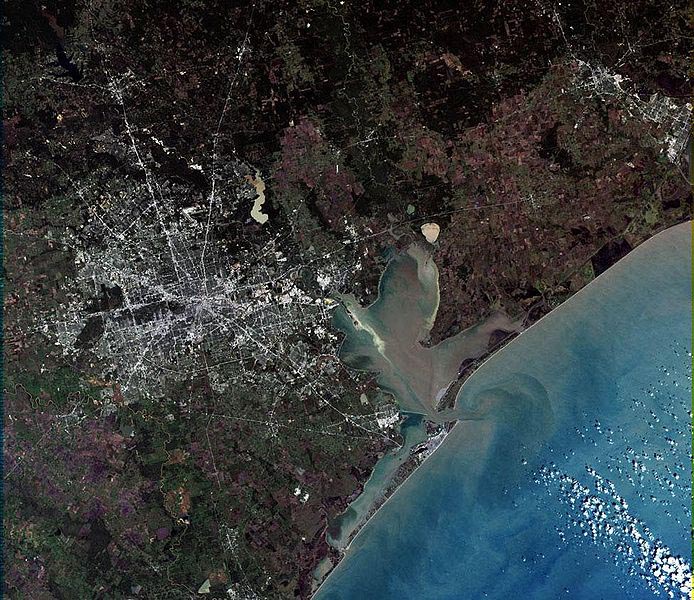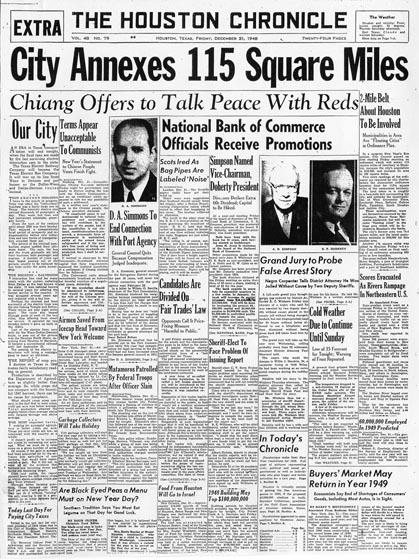
History is where you find it . . . often in bits and pieces . . . a puzzle to be assembled.
At the University of Houston Libraries, Special Collections we have one piece of the historical puzzle known as the Sunset Coffee Building. Only a few yards from Allen’s Landing, where the city was founded, this building has been a fixture downtown since 1910. A century ago its waterfront location permitted access to boats and barges headed to Galveston Bay and beyond. It had many uses over the years until it was abandoned and left to decay. In 2013 Houston First Corporation and the Buffalo Bayou Partnership announced a restoration and adaptive reuse project that would turn the Sunset Coffee Building into a downtown cultural and entertainment destination. (For more information, see “Our Vision: Sunset Coffee Building”.)
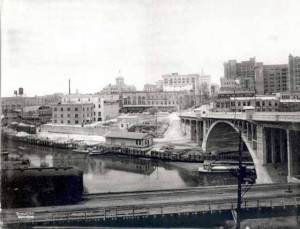
Allen’s Landing, early 1900s. Sunset Coffee Building is left of center, in front of white building. Photo by Frank J. Schlueter. Courtesy Houston Public Library
For this puzzle we have a piece at the beginning (1910) and a piece at the end (2013), but what about the pieces in the middle? No doubt there are many, but Special Collections holds a significant one, which can be found in the Burdette Keeland Architectural Papers.
Burdette Keeland (UH 1950) was a prolific designer and an influential member of the UH Architecture faculty. To his students, he was cool. Joe Mashburn, later Dean of the College of Architecture, recalled, “I remember Burdette Keeland, Jr. emerging from his gray MG roadster and walking across that asphalt with his suit jacket over his shoulder and smoking a thin cigar. As students, we thought this was the way it should be for an architect – a cool sports car, a sleek Italian jacket. We wanted to be like him.” (“Burdette Keeland Jr. Remembered,” Cite 48 (Summer 2000), 9).
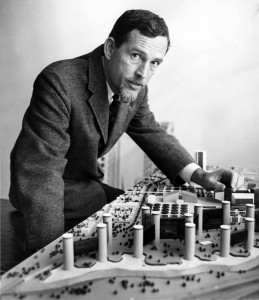
Burdette Keeland, Jr., late 1960s. Burdette Keeland Architectural Papers, UH Libraries, Special Collections (“Keeland Papers”).
In the late 1960s the cool Mr. Keeland was part of a joint venture that bought what is now known as the Sunset Coffee Building with plans to develop it as an entertainment venue. Keeland acted as architect for the group and provided space for a restaurant and two nightclubs. To reach them, he added a three-story outdoor staircase, and in keeping with the spirit of the times, later painted the building in a wild psychedelic color scheme.
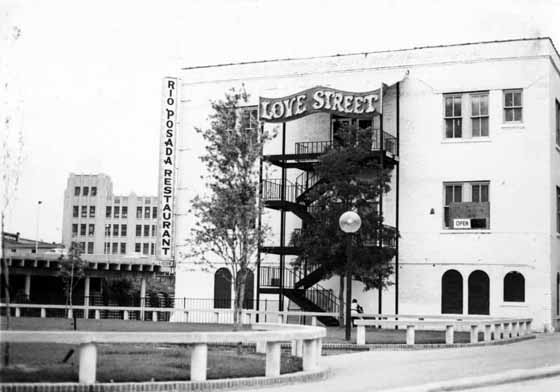
Love Street Light Circus and Feel Good Machine (c. 1967). Keeland Papers.
The top floor became home to the celebrated Love Street Light Circus and Feel Good Machine, run by artist David Adickes. From 1967 to 1970 Love Street hosted many of the top local bands of the day, such as the 13th Floor Elevators, Fever Tree, the Moving Sidewalks, and later, ZZ Top. Go-go dancers joined the bands onstage, while patrons lounged on the floor enjoying refreshments. (For more on Love Street, see “David Adickes – Love Street Light Circus and More” or “LOVE STREET LIGHT CIRCUS
AND FEELGOOD MACHINE!!!”)
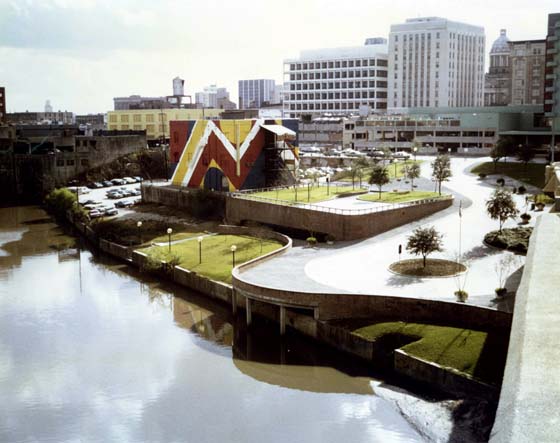
Sunset Coffee Building with psychedelic paint scheme (c. 1971). Keeland Papers.
For a few years the building played an important role in Houston’s version of the “Summer of Love,” the heyday of the hippies and the counterculture movement. Popular with its patrons but unsuccessful as a business, Love Street closed in 1970. Keeland and his partners later sold the building. It was a short but colorful chapter in the life of this historic building. At Special Collections we have many such chapters, each waiting for researchers to fit them into their proper places in a larger historical puzzle.
This spring 2016 semester we are proud to partner once again with the English Department’s Professional Internship Program and host Elizabeth Beaver, our newest UH Special Collections Social Media Intern. As part of her duties, Beaver will be researching, drafting, and editing content for the Special Collections blog as well as our Facebook page. In her first contribution, she examines the founding and evolution of African American Studies at the University of Houston.
1969: The Dawn of a Trailblazing Academic Program
Elizabeth Beaver
Today, I would like to pay homage to our very own African American Studies Department which has its roots in the civil rights movement of the 1960s.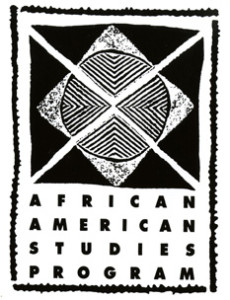
The 1960s were a time of intense civil rights activism which generated a great deal of momentum for issues of racial equality. In comparison to the national ferocity, the citizens of Houston presented a more subdued and subtle front. A city-wide media blackout and backroom negotiations allowed the city to quietly take on the task of integrating its large, commercial establishments without the horrific scenes of violent clashes taking place in other Southern cities. Despite this compromised and negotiated “peace” of the period, University of Houston students’ demands for changes in the curriculum found them standing at the fore of the evolution of Liberal Arts education in the South. In 1969, dissatisfied with the status quo, the student organization Afro-Americans for Black Liberation (or AABL) presented University President Philip Hoffman with a list of ten demands. The 1969 Houstonian reports that the so-called demands included “more black administrators and instructors,” “a raise in the pay scales for maintenance employees,” as well as the establishment of “an Afro-American studies department.” The University rose to the demands of the students, as well as the changing social climate of the city itself, and launched a number of African American Studies courses in the spring of 1969.
Exploring a new field of study, the African American Studies Program actively invited interest and education in an important cultural field that had previously been entirely sidelined. In an era rich with advocacy and public protest, the University of Houston was quick on the heels of the first program in the nation (offered by San Francisco State University in 1968), and was the first in Texas and the Southeastern United States to offer one of these trailblazing programs.
The value of education may be a given. However, the establishment of the African American Studies Program illustrated this importance in two ways: 1) It provided expanded educational opportunities to individuals (of all colors and creeds) in a field of study that had reached a critical mass of interest and demand and 2) exemplified that education served a larger, societal impact, given the previous marginalization of scholarship related to the African American experience.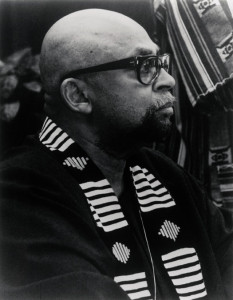
Over the years, the AAS Program has hosted many notable speakers, including highly acclaimed scholar and writer Dr. Maulana Karenga, astronaut and former UH Graduate Bernard A. Harris, and many other distinguished leaders. Our archives contain records from when Dr. Karenga came to speak in February of 1995, and include travel details and information related to the talk and panel, “Black Studies, Social Policy and Social Practice: Joining Campus and Community.” As a prominent scholar in his field, astronaut, and UH graduate, Bernard Harris was invited to the university by the AAS Program to give a talk in January of 1994. Only a year later he was a member of NASA’s STS-63 Crew and became the first African American to take part in Extravehicular Activity or “EVA” (NASA nomenclature for a spacewalk)! The organization plans and details for his campus talk can be found in our African American Studies Records. The folder contains, among other things, personal details and biographical information, education and honors received, as well as mission highlights from the time he logged in space. We also have a video interview of Harris (available digitally, as well) if you are interested in learning more about this esteemed astronaut and UH alum.
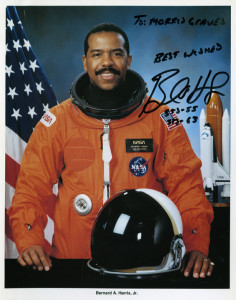 The current African American Studies Department is the result of significant growth over numerous decades and the recent efforts by university authorities. In March of 2014, CLASS Dean John W. Roberts appointed a task force dedicated to the growth and development of the AAS Program. By the next year, it was a fully formed department making plans for African American History Month. The current department has big plans for this year as well, now boasting a wide selection of courses and opportunities for community outreach. The department enjoys a longstanding study abroad relationship with Gambia, as well as numerous scholarship offerings. The department has grown to match the needs of the University and the city as they develop and change, and it continues to impact Houston’s diverse cultural environment in increasingly positive ways. The program organizes many different off and on-campus talks and events as well as community involvement opportunities, and has hosted numerous visiting scholars over the years.
The current African American Studies Department is the result of significant growth over numerous decades and the recent efforts by university authorities. In March of 2014, CLASS Dean John W. Roberts appointed a task force dedicated to the growth and development of the AAS Program. By the next year, it was a fully formed department making plans for African American History Month. The current department has big plans for this year as well, now boasting a wide selection of courses and opportunities for community outreach. The department enjoys a longstanding study abroad relationship with Gambia, as well as numerous scholarship offerings. The department has grown to match the needs of the University and the city as they develop and change, and it continues to impact Houston’s diverse cultural environment in increasingly positive ways. The program organizes many different off and on-campus talks and events as well as community involvement opportunities, and has hosted numerous visiting scholars over the years.
We invite you to come by the reading room to catch a few exciting glimpses into the history of this exemplary academic program via the the University Archives and the African American Studies Records!
Whether it’s a rare book printing found at long last or piece of ephemera found in an archival collection by chance, those who visit the University of Houston Special Collections almost always find something they cannot wait to share with others. Here we celebrate what makes the University of Houston Special Collections so special–our Favorite Things.
The satellite view is spectacular and confirms what we already know—Houston is big. At last count, Houston’s incorporated area covers about 667 square miles. We know this because the City of Houston Planning & Development Department has created an informative slide show that illustrates the city’s ever-changing boundaries. “Annexations in Houston or How we grew to 667 square miles in 175 years” can be found online.
If you want to research urban planning in Houston the old-fashioned way—using text and images printed on paper—try the Special Collections Department at UH Libraries. I recommend the old-fashioned way because, while it is not as convenient as surfing the web, it is way more fun.
Discoveries abound in Special Collections. Every folder holds a surprise. My most recent discovery was a set of maps from the Paddock Greater Houston Convention & Visitors Council Records. As the name suggests, this collection contains records collected by Marianita Paddock from her years with the Greater Houston Convention & Visitors Council. But it also includes maps of cities and counties in Texas from the mid-twentieth century. Some of the maps are common but others are unusual, such as a 1948 Ashburn’s Map of Houston in a special edition issued for Forest Park cemetery on Lawndale.
The most significant is the City of Houston’s Zoning District Map, December 15, 1947. Houston was small once, and I don’t mean when the Allen Brothers founded it in 1836. As late as the 1940s, it was a compact city of 75 square miles. This map reminds us that in 1947 the city’s boundaries extended no farther than Kirby Drive on the west, Brays Bayou on the southwest, and Sims Bayou on the southeast. The Heights, Rice Institute, and the new Texas Medical Center were on the edge of town.
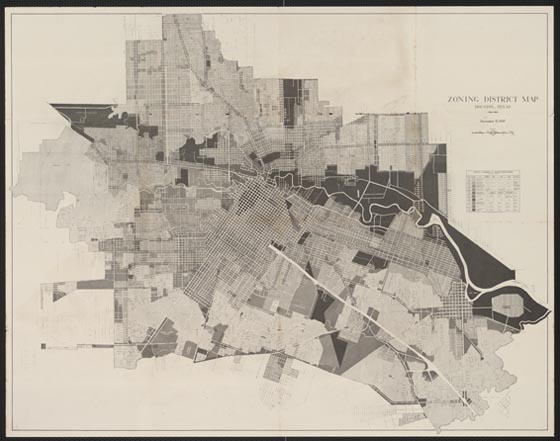
City of Houston, Zoning District Map, December 15, 1947, Paddock Greater Houston Convention & Visitors Council Records
The map is a historical footnote to the larger question of urban planning in Houston. Most people know that Houston is the largest city in the country without land use zoning. So why was the city publishing a zoning map? The answer is that it was done to educate citizens about the issues in the upcoming special election in January 1948 when they would be asked to approve a new law authorizing zoning. It’s no spoiler to say that voters rejected the law. Progressives in Houston are gluttons for punishment and tried again in 1962 and 1993. Voters were unmoved and we still have no zoning.
More importantly, the map is a detailed snapshot of the city’s boundaries, street system, and land uses on the eve of its great suburbanization. On December 31, 1948, only a year after the map was published, the city council approved an ordinance annexing a large swath of territory that more than doubled the city’s land area to 189 square miles. Houston was small no more. This was the first of many annexations, done to preserve the city’s tax base and its ability to grow.
City council waited until New Year’s Eve to drop this bombshell. The Houston Chronicle responded with a banner headline. Pasadena and other neighboring cities were not thrilled by the news. Their New Year’s hangover was beginning early and would continue for decades more.
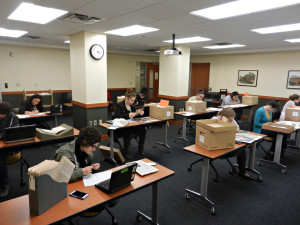
Dr. Leandra Zarnow’s students paid a visit to UH Special Collections early in the spring 2016 semester.
The Instruction Program at the University of Houston Special Collections continues its growth and impact on teaching and learning around campus, at both the undergraduate and graduate level.
The fall 2015 semester saw our Evans Room welcome a number of first-time visits from UH professors and their classes, as well as the continuation of some long-standing partnerships that have made Special Collections a permanent fixture on the class schedules across a number of disciplines. University Archivist Mary Manning hosted Dr. Lyle McKinney’s “History and Philosophy of Education,” where students consulted with the University Archives to trace the growth of not only the University as a whole (from its origins as a junior college, through its explosive growth following WWII, and the evolution of student life into the late 20th century), but also of individual disciplines and courses offered at UH. Dr. Roberto Tejada visited Special Collections with two of his classes (“Advanced Projects in Literary Translation” and “Master Poetry Workshop”), where Hispanic Collections Archivist Lisa Cruces shared a number of artists books from North America and Latin America, and students were able to engage in the challenges of translation with these materials.
Instructors for classes held in Special Collections included archivists from Special Collections as well as specialist librarians from other departments. In an exciting outreach collaboration Porcia Vaughn, Biology & Biochemistry Librarian, visited Dr. Lawrence Williams’s “History and Philosophy of Biology” class to highlight and discuss some of the rich resources hosted among the rare books available for research in the natural sciences. Those students in turn visited our reading room to consult with science texts dating back centuries, providing an opportunity for keen and curious eyes to trace the development of the scientific revolution.
Now, the spring 2016 class schedule is in full swing. Dr. Jesse Rainbow, Dr. Leandra Zarnow, and Dr. David Mazella have already visited Special Collections this semester. In addition to what has become a very full and recurring schedule, Coordinator for Instruction Julie Grob has scheduled a number of new and interesting collaborations with the Honors College and a number of departments across the humanities. Students of Dr. Bill Monroe will visit to explore some of our resources related to literary and visual artists of the American Southwest. Also scheduled to visit Special Collections as part of their instruction are Dr. James Zebroski’s “Introduction to LGBT Literature,” Dr. Mark Allan Goldberg’s “U.S. Latina/o Histories,” and Honors College students from the “Ideology and Empire: Russia” course of Dr. David Rainbow.
As part of our mission to support the teaching and research activities of the University of Houston, Coordinator for Instruction Julie Grob works with professors to leverage the wide variety of resources in Special Collections into the everyday teaching and learning at the University of Houston. Be sure to contact Julie if you are interested in exploring future collaborations to impact your classroom.
Whether it’s a rare book printing found at long last or piece of ephemera found in an archival collection by chance, those who visit the University of Houston Special Collections almost always find something they cannot wait to share with others. Here we celebrate what makes the University of Houston Special Collections so special–our Favorite Things.
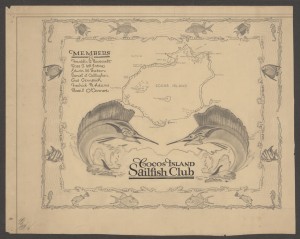
Cocos Island Sailfish Club decorative map, ca. 1934-1935, Cruiser Houston Collection
Today, one of my favorite things is also one of our newest things–the “Cocos Island Sailfish Club” decorative map.
The University of Houston Special Collections recently acquired the hand-drawn map commemorating the Cocos Island Sailfish Club, as part of the Cruiser Houston Collection. Prior to her fateful service at the outbreak of World War II, the Houston, often served as the transport of choice for its most famous passenger–President Franklin D. Roosevelt. Throughout the 1930s and 40s, Roosevelt set out on four cruises aboard the Houston. Presidential cruises in the Pacific during the years 1934 and 1935 included fishing expeditions to the Cocos, the Galapagos, and other Pacific isles.
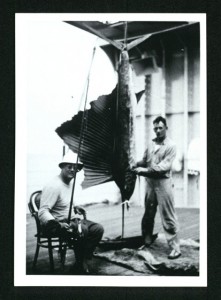
Franklin D. Roosevelt, deep sea fishing on USS Houston (Cruiser Houston Collection, high resolution download available through our Digital Library)
The Cruiser Houston Collection contains photographs documenting these excursions, including photographs of the President with his sailfish catch. Now, the addition of this particular item will provide further context for the peacetime activities of the Houston. Depicted on the commemorative map are the Cocos, accentuated by drawings of large sailfish, bordered by drawings of other imagery and fish from the tropics, as well as a named roster of “club members”: Franklin D. Roosevelt, Ross T. McIntire (Vice Admiral, personal physician of President Roosevelt), Edwin M. Watson (Major General, military aid to President Roosevelt), Daniel J. Callaghan (Rear Admiral, naval aide), Gus Gennerich (bodyguard and personal aide), Frederick B. Adams (secretary), and Basil O’Connor (legal advisor and former partner).
Those interested in getting a closer look at the Cocos Island Sailfish Club are encouraged to see it in person by visiting our reading room. Others may get a sense of the detailing of the map by viewing a digitized version, courtesy of our colleagues in Metadata and Digitization Services. Finally, those interested in more information on this item or the Cruiser Houston Collection should contact Christian Kelleher, Head of Special Collections and curator of the USS Houston & Military History collections.
